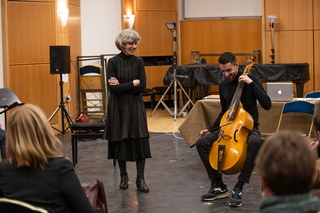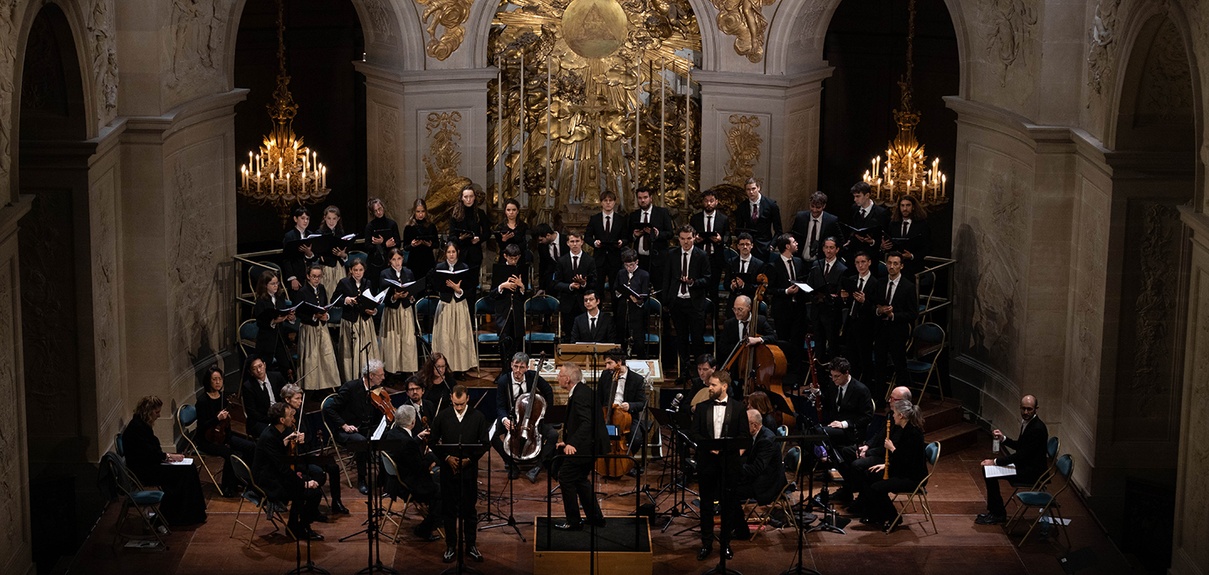Plongée dans la création de Janus
Hier et demain, répertoires du passé, musiques de l’avenir : quels sont selon vous les points communs entre le CMBV et l’Ircam ?
 Fabien Armengaud : On pourrait penser que nos deux institutions sont très différentes du fait de leurs sujets d’étude apparemment diamétralement opposés… Erreur ! Ce sont deux grands centres de recherche et il existe de nombreuses similarités dans nos démarches respectives, que ce soit celle du CMBV, créé en 1986, tournée vers la musique baroque et celle l’Ircam, né en 1977, avec la musique contemporaine et notamment la création électroacoustique. Les équipes des deux maisons questionnent sans cesse les répertoires, les notions d’interprétation, de restitution et de diffusion… Côté purement musical, nous sommes tous, inlassablement, à la recherche d’un son.
Fabien Armengaud : On pourrait penser que nos deux institutions sont très différentes du fait de leurs sujets d’étude apparemment diamétralement opposés… Erreur ! Ce sont deux grands centres de recherche et il existe de nombreuses similarités dans nos démarches respectives, que ce soit celle du CMBV, créé en 1986, tournée vers la musique baroque et celle l’Ircam, né en 1977, avec la musique contemporaine et notamment la création électroacoustique. Les équipes des deux maisons questionnent sans cesse les répertoires, les notions d’interprétation, de restitution et de diffusion… Côté purement musical, nous sommes tous, inlassablement, à la recherche d’un son.
Clément Buonomo : Il faut créer des passerelles entre les répertoires français. Il y a une vraie proximité entre nos deux structures et ce qu’elles représentent sur le plan musical, c’est-à-dire, côté CMBV, toute une réflexion sur l’apport esthétique, ornemental, stylistique des répertoires des XVIIe et XVIIIe siècles français et leur influence. Pour la musique contemporaine à l’Ircam, ce sont toutes les spécificités d’écriture, la création électroacoustique, les diverses écoles de composition qui ont existé au XXe siècle et qui ont essaimé ailleurs dans le monde. Nos deux structures ont en commun le rapport au temps – musiques du passé, du présent et de l’avenir – mais aussi… le temps de mener à bien des projets de longue haleine. Une vraie nécessité aujourd’hui.
Photo : Fabien Armengaud, directeur artistique et musical de la Maîtrise du CMBV © Pascal Le Mee
Comment avez-vous œuvré à cette rencontre entre les deux univers musicaux : celui des Pages et des Chantres du CMBV et ceux de quatre compositeurs et compositrices d’aujourd’hui ? Comment susciter une alchimie ?
Clément Buonomo : Rappelons qu’à la Maîtrise, nous travaillons avec des étudiants – des enfants, de jeunes adultes – qui, pour la plupart, ne connaissent pas du tout le répertoire contemporain ! C’est un véritable dialogue qu’il a fallu nouer cette dernière année. D’abord, nous avons appris à nous connaître. Côté compositrices et compositeurs, Ariadna Alsina Tarrés et Justina Repečkaitė avaient déjà quelques notions en musique ancienne, c’était moins le cas de Jug Marković et d’Adrien Trybucki qui arrivaient en terrain vierge.

De gauche à droite : Ariadna Alsina Tarrès (© Laura San Segundo), Adrien Trybucki © Fondation Royaumont, Justina Repečkaitė (© Dan Spigelman) et Jug Marković (© Ben Vieaperalta)
Fabien Armengaud : Nous n’avons pas voulu d’un projet où l’on se serait dit « Allez, on va faire des créations, point ». Non. Il y a un vrai chemin commun, un véritable compagnonnage entre la Maîtrise et les quatre compositeurs et compositrices, sans oublier les ingénieurs du son de l’Ircam. Ils sont venus plusieurs fois en exploration au CMBV avant de se mettre à l’ouvrage. Chez nous, ils se sont familiarisés avec notre façon de travailler et, bien sûr, le son du chœur. Nous leur avons présenté en détail un large panel d’œuvres représentatives du baroque français et les partenaires du CMBV leur ont présenté plusieurs instruments anciens avec leurs particularités et possibilités techniques et expressives, comme l’orgue ou le théorbe qui offrent un champ des possibles enthousiasmant aux compositeurs d’aujourd’hui. L’exploration et la familiarisation ont ainsi eu lieu dans les deux sens ! Ariadna Alsina Tarrés et Adrien Trybucki, dont les œuvres seront respectivement créées en juin 2023 et juin 2024, ont présenté leur univers musical avec des écoutes commentées afin que petits et grands, les Pages, les Chantres – et nous-mêmes ! – puissions entrer dans leur langage et leur imaginaire.
 Clément Buonomo : Puis, dans un deuxième temps, en juin 2022, au Centquatre, nous avons organisé une grande journée de travail avec une « performance practice » publique autour d’une sélection de pièces d’Adrien et Ariadna. Ils avaient choisi des échantillons qui présageaient déjà de ce à quoi allaient ressembler leurs futures créations, histoire de nous mettre en appétit et toujours dans ce souci d’immersion de nos choristes dans des univers musicaux inconnus pour eux. Bien sûr, il a fallu leur donner les codes de ces musiques d’aujourd’hui. Cette mise en situation est vertueuse d’un point de vue artistique : elle leur fait comprendre que la musique s’exprime de bien des façons. Ces esquisses ont aussi permis aux compositeurs de voir quelles étaient les ressources et les limites du chœur, en termes d’ambitus, de son, de difficultés techniques, etc.
Clément Buonomo : Puis, dans un deuxième temps, en juin 2022, au Centquatre, nous avons organisé une grande journée de travail avec une « performance practice » publique autour d’une sélection de pièces d’Adrien et Ariadna. Ils avaient choisi des échantillons qui présageaient déjà de ce à quoi allaient ressembler leurs futures créations, histoire de nous mettre en appétit et toujours dans ce souci d’immersion de nos choristes dans des univers musicaux inconnus pour eux. Bien sûr, il a fallu leur donner les codes de ces musiques d’aujourd’hui. Cette mise en situation est vertueuse d’un point de vue artistique : elle leur fait comprendre que la musique s’exprime de bien des façons. Ces esquisses ont aussi permis aux compositeurs de voir quelles étaient les ressources et les limites du chœur, en termes d’ambitus, de son, de difficultés techniques, etc.
Fabien Armengaud : D’un point de vue plus pragmatique, il a été nécessaire d’organiser ces master classes car les partitions de ces pièces de musique électroacoustique présentent d’autres difficultés de lecture et de compréhension, notamment pour de jeunes chanteurs habitués aux pages baroques. En les déchiffrant, on met plus de temps à en trouver le sens. Malgré cette première difficulté, un tel pas de côté est évidemment très enrichissant.
Photo : Clément Buonomo, directeur adjoint de la Maîtrise du CMBV © Morgane Vie
Une des quatre œuvres composées dans le cadre du projet Janus sera créée le 22 juin prochain : qu’a-t-elle retenu de l’héritage baroque français ?
Fabien Armengaud : Nous n’avons pas encore en main les partitions complètes et il faut préciser que les œuvres comportent à la fois des parties live et des parties enregistrées que nous montons au fur et à mesure. Comme nous le disions, les quatre compositeurs sont repartis du CMBV et de nos échanges imbibés de musique baroque française, de sons et d’informations ! Ariadna s’est inspirée de petits motets de Lully à trois voix de dessus, peu donnés. Concernant les trois œuvres qui seront créées l’an prochain, nous savons déjà que le compositeur serbe, Jug Marković, est tenté par l’écriture d’une pièce à six voix, et que la compositrice lituanienne, Justina Repečkaitė, souhaite écrire sur la mue des voix d’enfant, une problématique qui nous touche chaque année ! Comment utilisait-on les voix muées à l’époque dans les maîtrises et les chapelles, et que devenaient ceux que l’on appelle les dessus mués ? Elle travaille donc à une pièce où l’on retrouvera tout un jeu de textures entre les différentes tessitures des voix de la Maîtrise. Le compositeur Adrien Trybucki, lui, a été saisi par l’architecture très particulière du double chœur qui est l’une des spécificités, l’une des signatures de la musique baroque française.
Clément Buonomo : Pour nos musiciens, les parties chantées en direct posent plus de questions que les parties enregistrées : ils sont très actifs et s’interrogent sur le sens de ce qu’ils chantent. Notre travail est de les guider, de leur expliquer l’interprétation de ces pièces, une compréhension esthétique. Bref, sinon de vulgariser, du moins de leur traduire ces œuvres.
« Il y a eu à l’Ircam des journées de travail assez magiques, comme l’enregistrement avec Ariadna, où nous étions tous ensemble, musiciens et compositeurs, avec nos bagages musicaux différents, dans un même processus de recherche sonore. C’était très intense… et émouvant ! » Fabien Armengaud






Photos : Visite des quatres compositeur.trice.s au Centre de musique baroque de Versailles © Morgane Vie
Quelles ont été les réactions des Pages et des Chantres lorsqu’ils ont découvert, avec vous, ces œuvres nouvelles ?
Clément Buonomo : Ils sont intéressés dès qu’on leur propose une nouvelle utilisation de leur instrument et que l’on s’éloigne de ce qui relève pour eux de l’habituel dans la technique vocale, qu’on les pousse à explorer les autres potentialités de leur voix – chuchotements, claquements, onomatopées ou murmures – ou lorsqu’on enlève tantôt la notion de mesure rythmique tantôt le paramètre de la hauteur de note fixe et qu’on part sur des hauteurs relatives. Cet élargissement de la palette leur plaît beaucoup, c’est complètement ludique pour eux. Le rendu final suscite davantage d’étonnement, parfois de l’amusement, en tout cas de l’interrogation. Les plus jeunes y vont la fleur au fusil, sans réfléchir, sans jugement. Les adultes questionnent davantage ce qu’ils ont sous les yeux.
Fabien Armengaud : La transformation par Ariadna d’un motet de Lully, avec des hauteurs différentes, a été très bien reçue par les musiciens : ils se sont jetés dedans comme dans un jeu. Nous avons lu la partition telle que Lully l’a écrite… puis avec les propositions et transformations opérées par Ariadna. Un régal !
Ces passerelles entre passé et présent seront d’ailleurs présentes dans le programme du concert avec un jeu de miroir entre les créations et les œuvres qui ont inspiré les compositeurs de l’Ircam…
Fabien Armengaud : Toujours dans cette volonté de dialogue et de réflexion sur l’héritage musical, nous proposerons en effet, en regard, des œuvres du répertoire baroque ayant inspiré ces créations. Quelle manière plus percutante pour le public que de saisir l’héritage qui existe entre la musique baroque française et des œuvres composées aujourd’hui ? Par exemple, pour la pièce à double choeur d’Adrien, nous interpréterons une œuvre qui l’a beaucoup marqué : un superbe motet à double chœur pour les trépassés de Marc-Antoine Charpentier. En regard de la pièce d’Ariadna, nous donnerons les trois petits motets à voix de dessus de Lully.
 Pages et Chantres du Centre de musique baroque de Versailles © Morgane Vie
Pages et Chantres du Centre de musique baroque de Versailles © Morgane Vie
Ce concert aura lieu à l’Espace de projection de l’Ircam où l’acoustique de la Chapelle royale de Versailles sera reconstituée : pourquoi est-ce important de retrouver cette acoustique historique ?
Fabien Armengaud : C’est une acoustique très intéressante et assez unique. Au début du projet, les compositeurs ont eu droit à une visite guidée de la Chapelle. Ils ont pu en tester l’acoustique et l’ont eu en tête lorsqu’ils composaient. Comme Lully, Lalande, Charpentier et bien d’autres avant eux, ils écrivent pour ce lieu. Au-delà de la prouesse technique des équipes de l’Ircam, la reconstitution de l’acoustique de la Chapelle royale a du sens musicalement parlant. On sait les grands acousticiens qu’ont été les fondateurs de la Chapelle et bien des œuvres ont été conçues pour ce lieu… et pour aucun autre.
Clément Buonomo : C’est aussi une question de bon sens et de confort musical. Nous travaillons les œuvres du programme chaque semaine à la Chapelle royale, en fonction de cette acoustique bien précise. Les interpréter dans un lieu à l’acoustique différente ne rendrait justice ni au travail de la Maîtrise ni aux œuvres au programme !
Propos recueillis par Suzanne Gervais, journaliste et autrice




